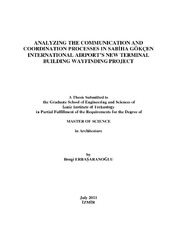Please use this identifier to cite or link to this item:
https://hdl.handle.net/11147/3087Full metadata record
| DC Field | Value | Language |
|---|---|---|
| dc.contributor.advisor | Doğan, Sevgi Zeynep | - |
| dc.contributor.author | Erbaşaranoğlu, Bengi | - |
| dc.date.accessioned | 2014-07-22T13:50:50Z | - |
| dc.date.available | 2014-07-22T13:50:50Z | - |
| dc.date.issued | 2011 | - |
| dc.identifier.uri | http://hdl.handle.net/11147/3087 | - |
| dc.description | Thesis (Master)--İzmir Institute of Technology, Architecture, İzmir, 2011 | en_US |
| dc.description | Includes bibliographical references (leaves: 105-108) | en_US |
| dc.description | Text in English;Abstract: Turkish and English | en_US |
| dc.description | xiv, 162 leaves. | en_US |
| dc.description.abstract | Coordination is the third main function following design and construction in the building process. It is a sensitive managerial activity involving well-defined procedures and smooth flow of communication in all directions to achieve project objectives. This study builds on existing coordination theory and utilizes the four key coordination processes defined by Malone and Crowston (1994): (1) Managing shared resources (2) Managing producer-consumer relationship (3) Managing simultaneity constraints (4) Managing task/subtask dependencies. Four processes were interpreted and operationalized for the study of the e-mail data obtained from the wayfinding project coordination of new terminal building of Sabiha Gökçen International Airport. The organizational schema of the wayfinding project defined the e-mail communication analysis to be among the contractors, consultant and the design firm. Social network analysis is conducted for network centrality measures. Degree, betweenness and closeness centrality values are calculated for each project participant. There are three major findings from these analyses. First finding suggests that centrally positioned Wayfinding and Signage Design Project Contractor in the organization schema shows more coordination. Second finding suggests that task/subtask dependencies, producer-consumer relationship, simultaneity constraints and shared resources need respectively more coordination effort to manage in a wayfinding project. Third finding shows e-mail communication has a profound effect on coordination. The implications of these findings mean that companies involved in design and construction process may consider providing new approaches affecting dayto-to-day interactions depending on the power of new technological coordination mechanism. | en_US |
| dc.language.iso | en | en_US |
| dc.publisher | Izmir Institute of Technology | en_US |
| dc.rights | info:eu-repo/semantics/openAccess | en_US |
| dc.subject.lcsh | Airport buildings | en |
| dc.subject.lcsh | Airport terminals | en |
| dc.title | Analyzing the Communication and Coordination Processes in Sabiha Gökçen International Airport's New Terminal Building Wayfinding Project | en_US |
| dc.type | Master Thesis | en_US |
| dc.institutionauthor | Erbaşaranoğlu, Bengi | - |
| dc.department | Thesis (Master)--İzmir Institute of Technology, Architecture | en_US |
| dc.relation.publicationcategory | Tez | en_US |
| dc.identifier.wosquality | N/A | - |
| dc.identifier.scopusquality | N/A | - |
| item.openairecristype | http://purl.org/coar/resource_type/c_18cf | - |
| item.languageiso639-1 | en | - |
| item.openairetype | Master Thesis | - |
| item.grantfulltext | open | - |
| item.fulltext | With Fulltext | - |
| item.cerifentitytype | Publications | - |
| Appears in Collections: | Master Degree / Yüksek Lisans Tezleri | |
Files in This Item:
| File | Description | Size | Format | |
|---|---|---|---|---|
| T000897.pdf | MasterThesis | 5.17 MB | Adobe PDF |  View/Open |
CORE Recommender
Page view(s)
9,334
checked on Mar 31, 2025
Download(s)
126
checked on Mar 31, 2025
Google ScholarTM
Check
Items in GCRIS Repository are protected by copyright, with all rights reserved, unless otherwise indicated.